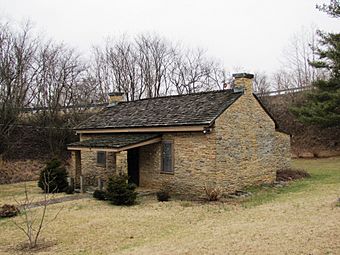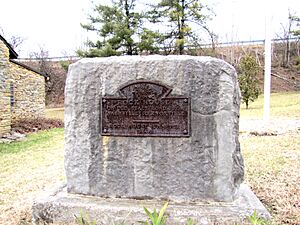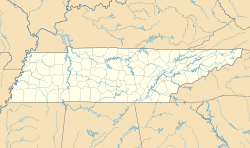Sparta Rock House facts for kids
Quick facts for kids |
|
|
Sparta Rock House
|
|
 |
|
| Nearest city | Highway 70, near Sparta, Tennessee |
|---|---|
| Area | 7 acres (2.8 ha) |
| Built | 1830s |
| NRHP reference No. | 73001856 |
| Added to NRHP | August 14, 1973 |
The Sparta Rock House State Historic Site is a special stone building located near Sparta, Tennessee. It was built a long time ago, in the late 1830s. This historic house used to be a place where people could stop and rest during their long journeys. It also served as a tollhouse, where travelers paid a small fee to use the road.
The Rock House was very important for people traveling between Knoxville and Nashville. This route was a busy wagon road, and travelers often needed a safe place to stay. They could get lodging and supplies here, especially after or before crossing the tough Cumberland Plateau. Because of its unique design and important role as a rest stop, the Rock House was added to the National Register of Historic Places in 1973.
The Rock House was likely built by Samuel Denton or brothers Barlow and Madison Fiske. The Fiske brothers were among its first operators. Even famous people like presidents Andrew Jackson and James K. Polk, and Governor Sam Houston, stayed here! It was a tollhouse and a store until the 1850s. Later, it was even used as a school between 1880 and 1921. Thanks to the efforts of the Daughters of the American Revolution, the state bought and started fixing up the Rock House in the 1940s. Today, the Tennessee Historical Commission helps manage it as a State Historic Site.
Where is the Rock House?
The Sparta Rock House is found where U.S. Route 70 meets White County Highway 2220 (Country Club Road). The property sits on a gentle slope. This area is where two different types of land meet: the Cumberland Plateau to the east and the Highland Rim to the west.
The elevation changes quite a bit around the Rock House. At Sparta, the road is about 900 feet (270 m) high. As you pass the Rock House, it rises to about 1,300 feet (400 m). Then, it climbs even higher to over 1,800 feet (550 m) as it reaches the top of the Cumberland Plateau. The Rock House State Historic Site also includes a large wooded area that stretches east towards Old Bon Air Road.
A Look Back: The Rock House's Story

The Walton Road was an old wagon road that connected Knoxville and Nashville. This road split into two branches at Crossville. One branch went northwest towards what is now Monterey. The other branch, which the Rock House was on, went west towards Sparta.
The Rock House was built between 1835 and 1839 on land owned by a local farmer named Samuel Denton. It's not completely clear if Denton or the Fiske brothers, Barlow and Madison, built it. However, the Fiske brothers were running the place by 1839. Besides being a place for travelers to stay overnight, the Rock House also collected tolls until the late 1850s. Back then, many wagon roads were managed by local people who charged a fee.
In the 1840s, a large hotel called the Bon Air Hotel was built a few miles east on the Plateau. This likely brought even more travelers past the Rock House. Sadly, the Bon Air Hotel was destroyed during the U.S. Civil War.
In the late 1800s and early 1900s, the Rock House was used as a home and a school. People simply called it the "Rock House School." In 1941, the Daughters of the American Revolution helped get money from the state of Tennessee to buy and restore the building. They then ran it as a public museum and a meeting place for their local group. A local craftsman named Clifton Broyle did a lot of repair work on the Rock House in the 1960s.
How the Rock House Was Built
The Rock House was originally a rectangular building made from local sandstone. This stone was dug up right from the area nearby. At first, a wall divided the building into two rooms. But that wall has since been removed, so the original part of the house is now one big room.
An old photograph from 1909 shows that the front of the house used to have a porch that was partly enclosed. However, by the 1940s, this porch had been taken down. In the middle of the 1900s, a new section was added to the back of the house. It was built with the same type of stone, but it included modern features. Inside the original part of the Rock House, you can still see large fireplaces at both ends. The wooden doors, window frames, ceiling, floor, and fireplace mantels are all original parts of the historic building.



